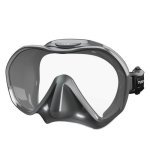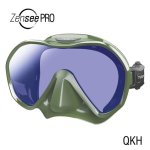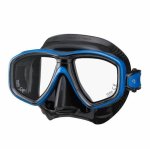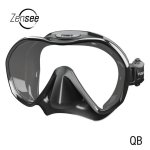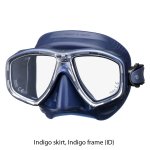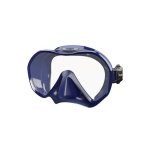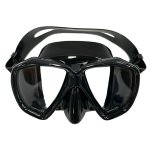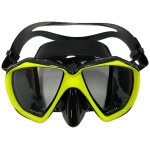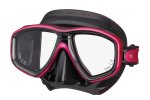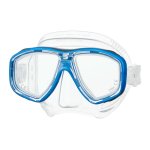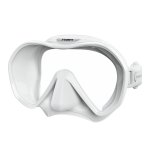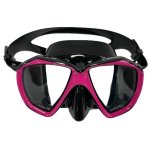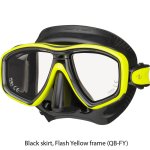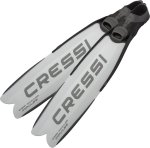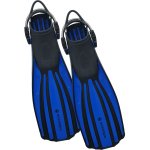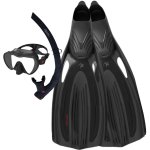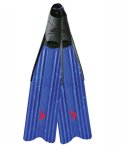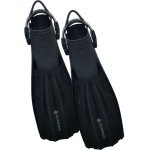Shop by Category
Info
Masks Snorkels and Fins show info...
Choosing Your Mask
A scuba diving mask is more than just a window through which to view the underwater world. Without a dive mask your eyes can't focus in the water. The space that a mask gives you lets your eyes focus the light normally and taa daa, you can see.
You would think that choosing a mask would be simple to do, but like any piece of scuba gear it takes some thought and research to pick the right scuba mask for you.
Types of Scuba Diving Masks
Single Lens Mask
The descendant of the oval frogman mask we all remember from old movies, modern single lens/pane scuba masks have almost nothing in common with their vintage counterparts.
For one thing they don't make you look like some big goggle eyed Cyclops. Hey, fashion is important.
Modern masks have silicon skirts to help fit better, as well a low profile design to bring the pane closer to the face and provide a wider range of vision.
Because the pane is all one piece this type of mask can't be outfitted as a prescription scuba mask.
Twin Lens Mask / Double Pane Mask
This is probably the most common type of mask around.
This scuba diving mask has a very low profile providing a wider range of vision than the single pane mask. The low profile also makes it easier to equalise at depth, as well as reduce mask 'squeeze'.
If you wear glasses a double pane mask can be outfitted as a prescription dive mask.
Some divers do complain about the mask sitting between the eyes, but most see past that and after a bit, don't even notice that it's there.
Full Face Mask
These masks are used mostly by commercial divers, although there are models made for recreational use.
A benefit of this style mask is that it can be outfitted with underwater communication so you can actually talk with your dive buddy or a surface team.
Some divers feel that because these masks are so comfortable to breath, you may actually end up going though more air than usual.
Things to Consider When Buying a Scuba Diving Mask
A mask is an essential piece of equipment for any diver or snorkeller. Masks are usually one size, however some differ depending on brand and style and will achieve a better fit than others. The main variable in this sizing is the head size ad face shape, as this is so individual to every person we cannot offer any sizing advise, other than to help out with checking the seal. The best way to check the seal on a mask is to fit it securely as if you were about to dive or snorkel, then breathe in through your nose. If the seal is good you can feel the vacuum on your face. If the seal is bad you will in take additional air.
Fit
- Hold the dive mask to your face and breath in slightly. Does it stick with no air leaks?
- Put the mask on all the way. If you use a snorkel, attach one and see if it still fits.
- Look in the mirror, does the inner skirt circle your face without crossing over your eyebrows or eye creases?
- Pinch your nose. Is it easy to reach through the skirt and can you equalise?
Skirt Colour
You can choose a clear or opaque silicon skirt.
An opaque skirt is good for a diver who does underwater photography or video. The opaque skirt helps to focus on the subject and avoid distractions.
A clear skirt lets light enter from the sides and helps with peripheral vision.
Multiple Panes
Some scuba masks have panes on the side and bottom to give a wider range of vision. The light can sometime act 'funny' with these masks and can be distracting. Definitely a matter of preference and something you should try before you buy.
Purge Valve
A built in purge valve can make it easier to clear your dive mask if it floods out.
A downside is that it could fail at depth leaving you in the position of cutting your dive short.
Scuba or Snorkelling
Make sure your nice shiny new mask is actually made for scuba diving. All of the masks listed here are suitable for scuba diving. If you use a mask that is only made for snorkelling you could end up in serious trouble when you exceed the depth limits of the mask.
Consider the type of diving you do and the conditions under which you dive, then make a check list of the features you are looking for in a mask.
If at all possible dive the different styles to see which you prefer.
Choosing the right scuba diving mask can be like going from a 15 inch black and white TV, to a 60 inch Full HD TV complete with home theatre.
Well maybe not that drastic, but better, definitely better.
Leaking Mask? Loosen The Strap!
If your mask is leaking, try loosening the strap, not tightening it. All mask straps, regardless of the type, are there just to keep the mask in the correct position and stop it being dislodged from your face, not to make the seal. The thin feather edge of the silicone mask skirt is what makes the watertight seal with the face. If the strap is too tight, the skirt and that feather seal will become warped and misshapen which can cause the mask to leak. If the mask is leaking slightly, tightening the strap even more will usually make the leak worse. With a properly set strap, some types of water entries might dislodge the strap, so make a habit of reaching back behind your head with one hand to steady the strap (not the mask) during entry. Any diver who exits the water and has a 'mask ring' indentation in their face probably has too tight a mask strap.
For more information please see our Scuba Buying Guides: Buying a Great Dive Mask and Avoiding Mask Squeeze,plus our Dive Gear Features pages: Mask Features and Fixing Underwater Vision Problems.
Tech Tip: Toothpaste is for Teeth
Please DO NOT use toothpaste, or other type of abrasive, on dive masks. There is NOT any 'factory coating' on the glass that needs to be removed to prevent fogging. You will either damage the lenses, or needlessly waste toothpaste since most modern toothpaste formulations are not at all abrasive. The lenses are made of the same optical quality materials used in eyeglasses and they don't need to be abrasively cleaned, it will only scratch the lenses.
The same goes for using a lighter to 'burn' the lens to prepare a new mask. The Scuba Doctor will not warranty masks that have been treated with abrasives or burned with lighters.
All new dive masks do have mould release agents on the flexible skirt that during storage will migrate to the surface of the glass and cause fogging. These deposits can easily and safely be removed with a powerful surfactant like Sea Buff, or Baby Shampoo. Please don't use abrasives.
See also, Dive Mask Care.
Note: Diving/snorkelling masks are very different to Swimming Goggles. See Goggles vs Masks.
Search Our Product Range

Tusa Zensee Mask | Gunmetal
-10%

Tusa Freedom Ceos Mask - Clear Skirt | FY
-10%

Tusa Zensee Pro Mask | Black
-10%

Tusa Zensee Pro Mask | Khaki
-10%

Tusa Freedom Ceos Mask | BK/MDR
-10%

Apollo SV-2 Diving Mask | Red
-12%

Tusa Freedom Ceos Mask | BK/FB
-10%

Tusa Freedom Ceos Mask - Clear Skirt | EO
-10%

Tusa Zensee Mask | Black
-10%

Tusa Freedom Ceos Mask | Indigo
-10%

Tusa Zensee Mask | Indigo
-10%

Apollo SV-2 Diving Mask | Black
-12%

Tusa Freedom Ceos Mask - Clear Skirt |BK
-10%

Tusa Freedom Ceos Mask | BK/EO
-10%

Apollo SV-2 Diving Mask | Yellow
-12%

Tusa Freedom Ceos Mask | BK/RP
-10%

Tusa Freedom Ceos Mask - Clear Skirt | FB
-10%

Tusa Freedom Ceos Mask | BK/OG
-10%

Tusa Zensee Mask | White
-10%

Apollo SV-2 Mask with Yellow Colour Correction Lenses

Tusa Freedom Ceos Mask | BK/BK
-10%

Apollo SV-2 Diving Mask | Magenta
-12%

Tusa Zensee Pro Mask | Gunmetal
-10%

Tusa Freedom Ceos Mask - Clear Skirt | T
-10%

Tusa Freedom Ceos Mask | BK/FY
-10%

Cressi Gara Modular Impulse Full Foot Fins - Blue - 40-41 (7-8)
-10%

Cressi Gara Modular Impulse Full Foot Fins - Blue - 36-37 (3-4)
-10%

Cressi Gara Modular Impulse Full Foot Fins - Blue - 42-43 (8-9)
-10%

Cressi Gara Modular Impulse Full Foot Fins - Black - 44-45 (10-1
-10%

Cressi Gara Modular Impulse Full Foot Fins - Blue - 38-39 (5-6)
-10%

Cressi Gara Modular Impulse Full Foot Fins - Blue - 44-45 (10-11
-10%

Cressi Gara Modular Impulse Full Foot Fins - Black - 46-47 (12-1
-10%

Cressi Gara Modular Impulse Full Foot Fins - White - 40-41 (7-8)
-10%

Cressi Gara Modular Impulse Full Foot Fins - White - 36-37 (3-4)
-10%

Cressi Gara Modular Impulse Full Foot Fins - White - 42-43 (8-9)
-10%

Cressi Gara Modular Impulse Full Foot Fins - White - 46-47 (12-1
-10%

Cressi Gara Modular Impulse Full Foot Fins - Blue - 46-47 (12-13
-10%

Cressi Gara Modular Impulse Full Foot Fins - White - 38-39 (5-6)
-10%

Cressi Gara Modular Impulse Full Foot Fins - Black - 40-41 (7-8)
-10%

Cressi Gara Modular Impulse Full Foot Fins - Black - 36-37 (3-4)
-10%

Cressi Gara Modular Impulse Full Foot Fins - Black - 42-43 (8-9)
-10%

Cressi Gara Modular Impulse Full Foot Fins - White - 44-45 (10-1
-10%

Cressi Gara Modular Impulse Full Foot Fins - Black - 38-39 (5-6)
-10%

Ocean Pro Avoca Fin | Blue | Extra Large 45-57
-24%

Ocean Hunter Seahawk MSF Set | Size L | US 10.5 - 11.5

Ocean Hunter Spirit Fin | Size 8-9 (41-42)

Ocean Pro Avoca Fin | Black | Small 36-40
-24%

Salvimar Neo Mask | Petrol
-22%








